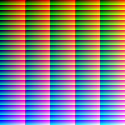Pinhole camera is here. As I already described and announced the creation of my own pinhole camera (in Slovenian, "luknjičarke") in a previous post, I finally had enough time and will to fulfill my promise. In the following, I will describe the entire manufacturing process and how to tackle it in the most appropriate way. For the most ambitious, I have prepared a complete kit with all measurements. I made a plan for a camera with a normal focal length, as well as a wide-angle one. I made the latter myself. Since I had good material at my disposal, I wanted a slightly more elaborate version.
First, of course, I watched some clips on YouTube and came to the conclusion that the best camera is to build around a 4 x 5 film cassette. Why? There are simply several reasons for this:
First of all, the film format is standardized and we can use flat film of appropriate dimensions, we can also use paper in the same cassette, which is the most common choice of "pinhole" photographers. Of course, by far the biggest reason is that we can change the cassettes in the field and we no longer depend on just one recording. In fact, each cassette has the option of inserting two films/paper, thus increasing our options even more. The 4 x 5 cassette is the standard cassette for large format cameras. In millimeters, it's something like 100 x 125 mm, which is quite a decent size for the final image, but of course we can still scan and enlarge it. Of course, they don't make cassettes anymore, but you can get them on the Internet (ebay) for a very good price. I myself paid exactly 100 EUR for 5 cassettes, if I take into account the postage and all taxes. The package arrived from faraway Japan with the help of Fedex mail in just 5 days! Conservation? As new.
Case making
Once I had the tape, I was able to build a system around it. For the test, I decided on a rather wide-angle version with a focal length of 55 mm, which means that the beam of light will not completely cover the entire paper, but the vignetting is also nice for me personally. In short, after a few sketches with a pencil, I started with the model, which I made right in the online 3D modeling program ThinkerCad (recommended!). When I saw that the parts fit together nicely, I made another part sheet (right in CorelDraw).
As a material, I chose the wood that my friend had available, i.e. cherry. For ease of manufacture, I constructed all the pieces all the same thickness of 8mm. Some pieces that are thicker consist of two pieces of the mentioned thickness. When cutting the wood, I made sure that all the pieces were cut really precisely, because otherwise the cassette will not go into the camera tightly and it can happen that the light inside will leak somewhere. Since the cassette is 120 mm wide, I worked with an excess of 2 mm, because later I taped the sides with black tape (hairy part of the hedgehog) so that the sealing against light is really good. Just assembling and gluing the parts was relatively easy, I just had to make sure that all the sides were really perpendicular to each other. When the glue was dry, I sanded the case and protected it with tung oil.
In the end, I drilled another hole in one of the sides, where I attached the nut/adapter for attaching it to the stand. For sealing and security, the 4 x 5 cassette will be held in place by two stronger elastics.
Making the front panel
For the front panel, I chose ordinary ultrawood, which is mostly used for the backs of cabinets. Since I had the opportunity, I asked a colleague who has a laser cutter to cut it out. Of course, we could do without it. On the edge of the central hole I mounted a simple shutter, which is nothing more than an ordinary piece of 3mm plywood and closes/opens the hole, where I later added a real tile with a 0.25 mm pinhole. I covered the front of the board with leather I had on hand for a nicer look, and sprayed the inside with matte black primer.
 plan and piece of 3 mm plywood
plan and piece of 3 mm plywood
 plan and piece of solid wood
plan and piece of solid wood
List of materials I used:
- Cherry wood 8 mm thick (casing)
- Ultrales panel 3 mm (front panel)
- Plywood 3 mm (shutter)
- Textile tape "hedgehog"
- 4 x 5 Infinitiy Elite Cassette
- Carpenter's glue
- Epoxy glue
- Some nuts and bolts
- Elastic band










